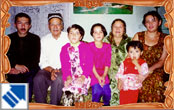



 |
 |
 |
 |
Most babies are born in a maternity hospital with the expectant fathers banished outside to ward off infection. The birth of a son is greeted with particular delight since it is he who will provide for his parents in later life. Bearing a male child gives the ‘kelin’ (bride) greater status and her mother-in-law may start allowing her kelin to address her directly instead of waiting to be spoken to, as is the Khiva custom with mothers-in-law and daughters-in-law.
A few days after the delivery, mother and child are whisked home where they remain in seclusion for forty days. Upon their homecoming, ‘flour plov’ is prepared and served to five neighbours in the belief that this will ensure a good supply of breast milk. When the baby is seven, twenty and forty days old, the proud grandmothers carry out a special washing ceremony in which they bathe the child in a concoction of water containing an egg white, a pinch of salt, a little soil, small pieces of beef and several coins. The water is not thrown out at the front door as usual but carefully poured against the wall at the back of the house. This ceremony is carried out as a symbol of the child’s hoped-for health and wealth as well as being a local remedy for the prevention of skin infections. The baby is formally named when he or she is a week old. It’s a simple and fairly private ceremony in which the local ‘mullah’ (holy man) prays for the baby and recites his or her name three times into each ear. In most cases, the baby’s name is chosen by the paternal grandparents according to the child’s place in the family, particular circumstances or their hopes and dreams for the child. For example, a sickly child is often named Umid (hope) and a child born after a previous miscarriage is called Toxtajan (stop). A boy born around the time of the major Navrus festival can be given the name Navrus and a girl born in place of a much longed-for son can be called Oghiljan instead, meaning son! Twins are fairly common and they are always given set names; Hassain and Hussain for boys and Fatima and Aisha for girls.
The most important event within a baby’s first forty days of life is being placed into the ‘beshik’ or cradle for the first time. In the case of the first child in a family, this is a big occasion which is organised by the mother’s relatives who supply the cradle and clothes for mother and child, plus all the food and drink for the ensuing party. Once the brightly painted wooden cradle has been delivered to the house by the mother’s aunt, the old women of the neighbourhood congregate to offer words of prayer and blessing for the baby. The child is passed from hand to hand until the oldest woman places the child in the beshik and sings a special lullaby. Two rounds of bread are placed underneath the cradle as is an unused potty filled with white sweets which are distributed to all the grannies. Later on in the day there is a bigger celebration with relatives and close friends. The beshik itself is a light wooden cradle used in Central Asia since time immemorial. It provides a place for the baby to sleep safely away from physical harm and is covered with thick curtains to protect from the evil eye. Often further spiritual security is given by keeping a knife, garlic, pepper, onion and bread underneath to scare away evil spirits intent on harming the child. Triangular charms are usually hung on top, stuffed with cotton and verses from the Koran.
Children sleep in a beshik until they are at least a year old although prolonged use can cause the back of the baby’s head to become flat. This is regarded as a desirable quality in boys since it means that Uzbek hats fit snugly! In the past this was also considered beautiful for girls, as Catherine Macartney discovered on her travels to Kashgar, ‘The Kashgari idea of beauty is that the head should be quite flat behind, to make the cap or turban set elegantly, and the long hair hang gracefully; and to achieve this, the new-born babies are tied flat on their backs in their wooden cradles, and are kept lying like that the most of the time till the bones of the back of the head have flattened and no curve or roundness is left.’
Catherine Macartney ‘An English Lady in Chinese Turkistan’ 1931
Perhaps the most fascinating aspect of the beshik is the ingenious toilet
system in which small tubes and a wooden pot take the place of nappies,
ensuring minimum mess and washing. It remains the same today as at the
time of Ella Maillart’s trip in 1932. Ella Maillart ‘Turkestan Solo’ 1933
|
|||||||
|
|||||||